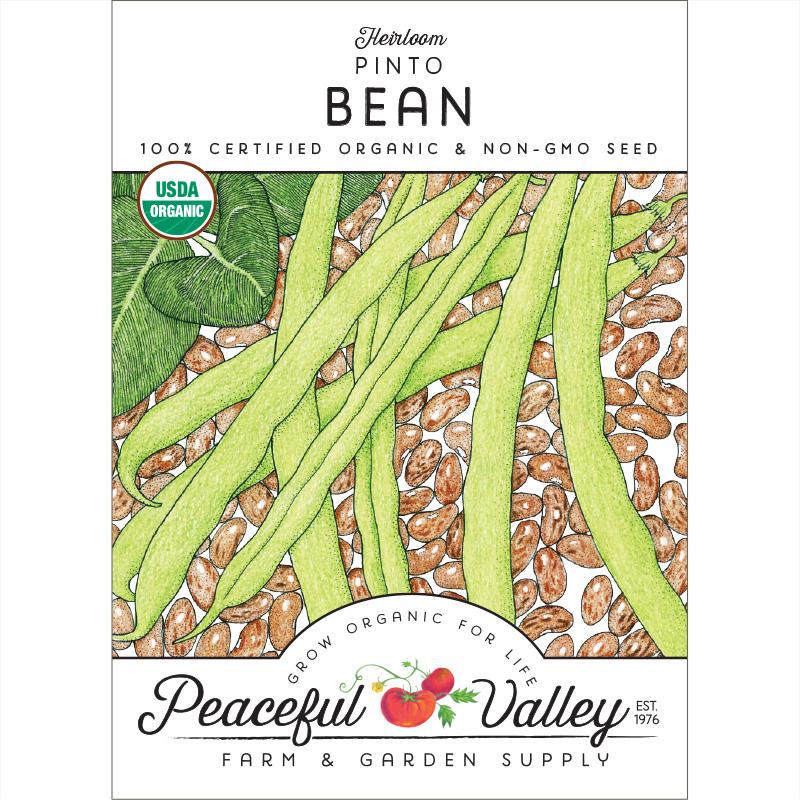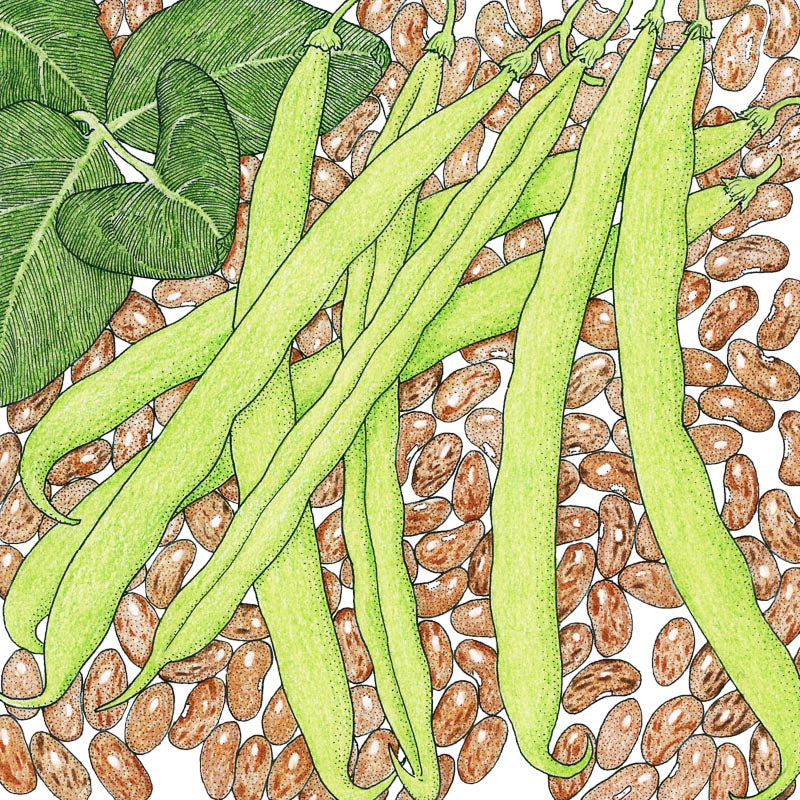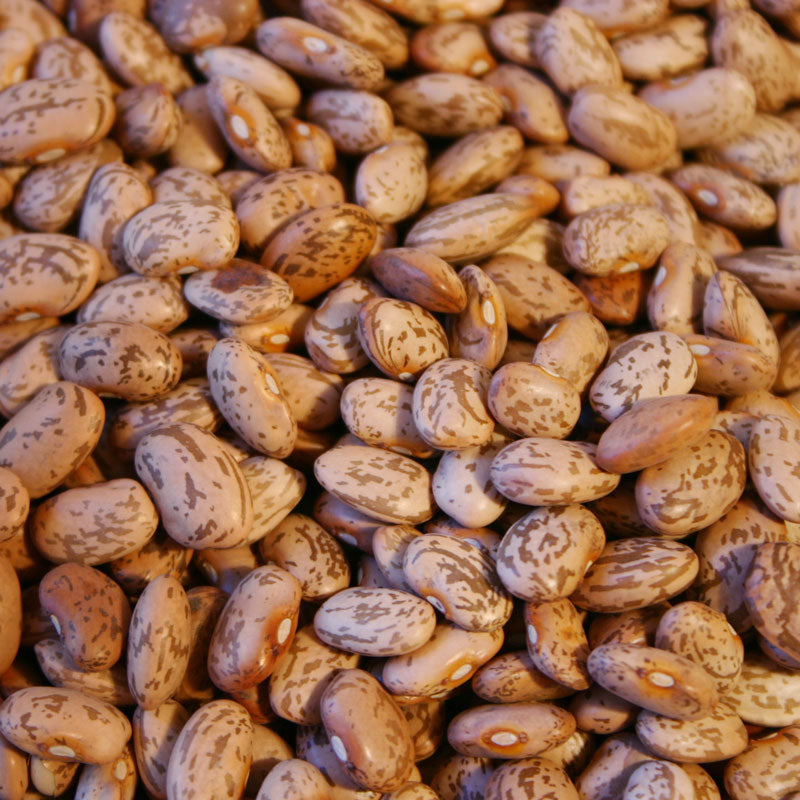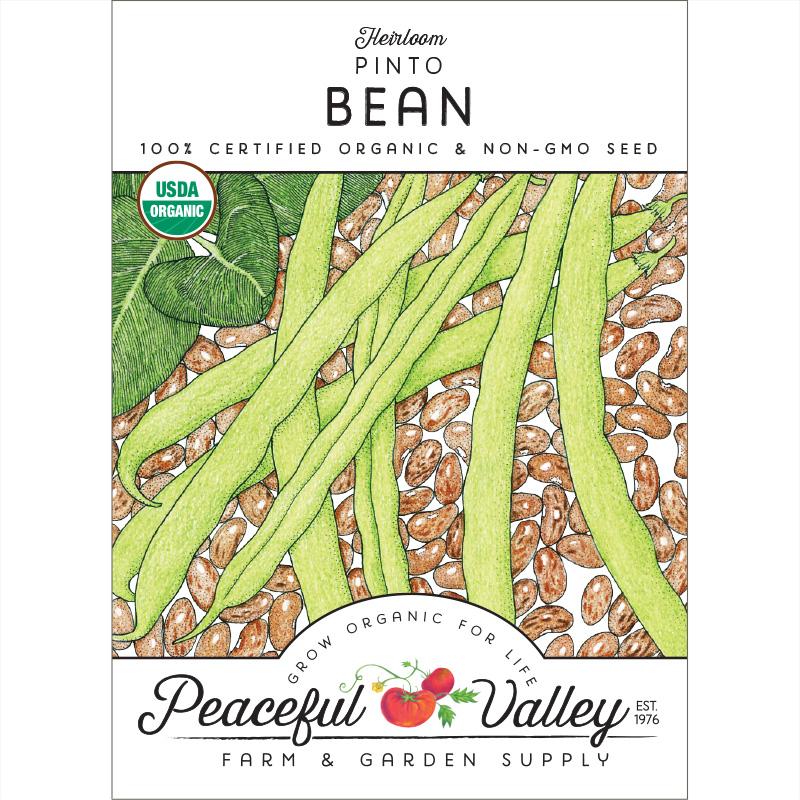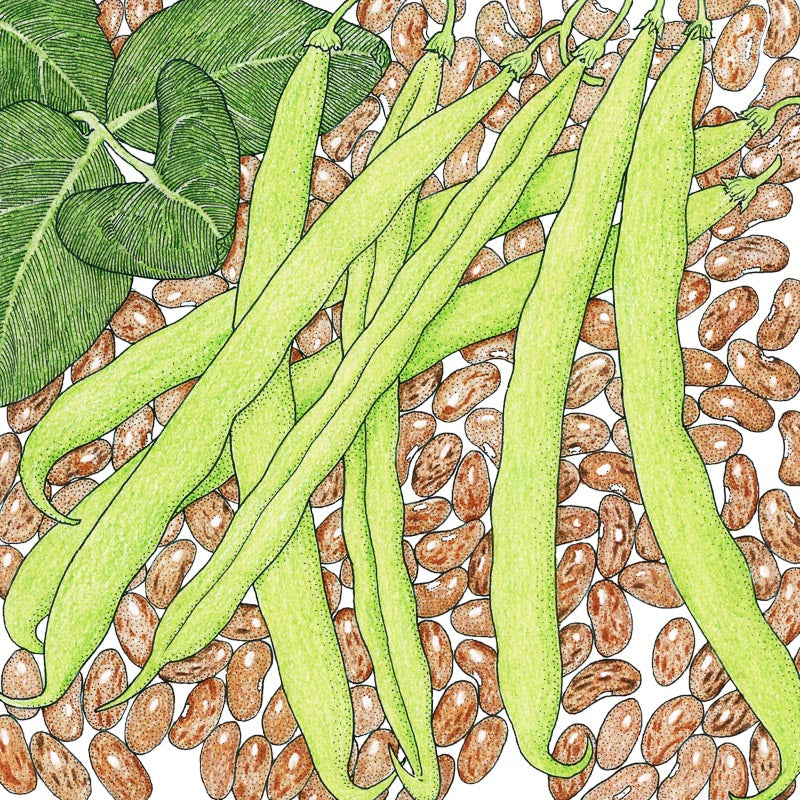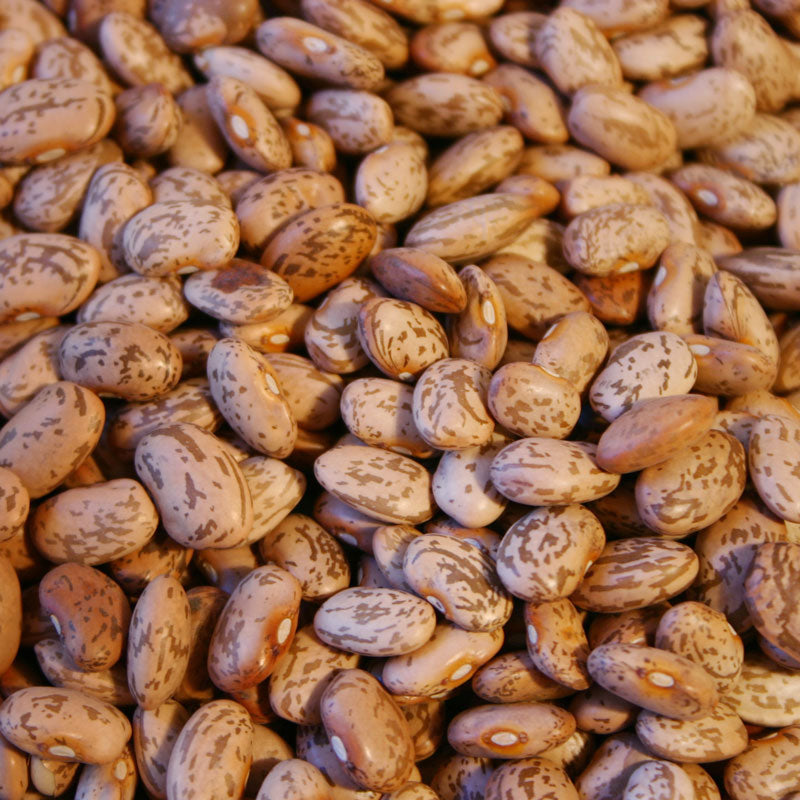Item Number: SNV8460
Pinto Bean Seeds (Organic)
Pinto Bean Seeds (Organic)
Pinto Beans - Popular Bean Used in Mexican Cuisine
Bean - Pinto - Phaseolus vulgaris
Tender Annual Bush. Dry. Heirloom. This speckled bean is the most popular bean in the U.S. and is beloved by kids and adults alike. Pinto beans are perfect for frijoles refritos, mashed in burritos, or served whole. Green (fresh) pintos are a gourmet treat in Mexico. The delicious mild flavor is the hallmark of this staple of Mexican cuisine.
Did You Know? Pinto beans get their name (like Pinto ponies) from their mottled coloring.
Soil & Water: Legumes like well-drained soil rich in organic matter and with a moderate amount of nutrients. Water lightly at planting, moderately at flowering, and heavily throughout harvest time. Avoid overhead watering.
Planting & Growing: Sow directly in garden when soils have warmed and danger of frost has passed. Keep seedbed evenly moist.
Harvesting & Storage: Bush beans will produce all of their fruit over a few weeks' time. Leave the pods on the plant until they have completely dried. Store dry, shelled beans in an airtight container.
Soil Temperature: 70-85°F
Planting Depth: 1"
Germination: 5-11 Days
Height At Maturity: 2’-3’
Days to Maturity: 75-85 Days
Sun/Shade:
Spacing After Thinning: 4"-6"
Approx Seeds per Pack: 50 Seeds
Pinto beans, scientifically known as Phaseolus vulgaris, are one of the most beloved and versatile legumes in the culinary world. These beige and speckled beans are renowned for their creamy texture and nutty flavor, making them a staple in various dishes, especially in Southwestern cuisine. Whether you're an experienced gardener or a novice looking to explore the world of homegrown produce, pinto bean seeds are an excellent choice for your garden.
Pinto Bean Basics
Appearance: Pinto beans are medium-sized, oval-shaped beans with a beige or light brown background and speckled or streaked maroon patterns. The name "pinto" is derived from the Spanish word for "painted," alluding to their distinctive appearance.
Flavor Profile: Pinto beans are known for their mild, earthy flavor with a hint of nuttiness. They have a creamy texture when cooked, which makes them an ideal candidate for a variety of culinary applications.
Cultivation of Pinto Bean Seeds
Planting Time: Pinto beans thrive in warm weather, so it's best to plant them after the last frost date in your region when the soil has warmed to around 60°F (15°C). In most areas, this typically falls in the spring.
Soil Requirements: Pinto beans prefer well-drained, loamy soil with a slightly acidic to neutral pH level. Ensure good drainage to prevent waterlogged roots.
Sunlight: These beans require full sunlight to grow successfully. Make sure they receive at least 6-8 hours of direct sunlight daily.
Spacing: When planting pinto bean seeds, space them about 2-4 inches apart in rows with 18-24 inches between each row. This spacing allows the plants enough room to grow and receive adequate airflow.
Watering: Keep the soil consistently moist but not waterlogged during the growing season. Beans are sensitive to drought stress, so regular watering is essential, especially during flowering and pod development.
Culinary Uses of Pinto Beans
Pinto beans are a versatile ingredient in the culinary world, particularly in Southwestern and Mexican cuisines. Here are some popular dishes and applications:
Refried Beans: Pinto beans are the primary choice for making refried beans, a staple in Mexican cuisine. These beans are cooked until soft, mashed, and then fried with onions and spices, creating a creamy and savory side dish.
Chili: Pinto beans are a common addition to chili recipes. Their mild flavor and creamy texture complement the bold and spicy flavors in chili dishes.
Baked Beans: Pinto beans can be used to make delicious baked beans. They are simmered with a savory tomato-based sauce, brown sugar, and spices, resulting in a classic American side dish.
Soups and Stews: Pinto beans are often added to soups and stews for their rich and hearty character. They absorb the flavors of the broth or sauce, enhancing the overall taste of the dish.
Salads: Pinto beans can be used in salads for added protein and a creamy texture. They pair well with fresh vegetables, herbs, and vinaigrette dressings.
Taco and Burrito Filling: Pinto beans make an excellent vegetarian filling for tacos and burritos. They are seasoned with spices and can be mashed or left whole, depending on the desired texture.
Pinto bean seeds are a fantastic addition to your garden if you appreciate the rich and earthy flavors of Southwestern cuisine. Cultivating these beans at home allows you to enjoy their versatility in a wide range of dishes, from soups to salads to hearty stews. With proper care and attention to their growing requirements, you can harvest a bountiful supply of pinto beans to elevate your culinary creations and savor the taste of this beloved legume.

Check Your Zone Compatibility:
Compatible with your zone.
Growing Zone for
,

Our Guarantee To You
Since 1976, we've served our customers at every stage of growing. Please contact us at any time. We are happy to support and assist you.
Description
Description
Bean - Pinto - Phaseolus vulgaris
Tender Annual Bush. Dry. Heirloom. This speckled bean is the most popular bean in the U.S. and is beloved by kids and adults alike. Pinto beans are perfect for frijoles refritos, mashed in burritos, or served whole. Green (fresh) pintos are a gourmet treat in Mexico. The delicious mild flavor is the hallmark of this staple of Mexican cuisine.
Did You Know? Pinto beans get their name (like Pinto ponies) from their mottled coloring.
Soil & Water: Legumes like well-drained soil rich in organic matter and with a moderate amount of nutrients. Water lightly at planting, moderately at flowering, and heavily throughout harvest time. Avoid overhead watering.
Planting & Growing: Sow directly in garden when soils have warmed and danger of frost has passed. Keep seedbed evenly moist.
Harvesting & Storage: Bush beans will produce all of their fruit over a few weeks' time. Leave the pods on the plant until they have completely dried. Store dry, shelled beans in an airtight container.
Soil Temperature: 70-85°F
Planting Depth: 1"
Germination: 5-11 Days
Height At Maturity: 2’-3’
Days to Maturity: 75-85 Days
Sun/Shade:
Spacing After Thinning: 4"-6"
Approx Seeds per Pack: 50 Seeds
Pinto beans, scientifically known as Phaseolus vulgaris, are one of the most beloved and versatile legumes in the culinary world. These beige and speckled beans are renowned for their creamy texture and nutty flavor, making them a staple in various dishes, especially in Southwestern cuisine. Whether you're an experienced gardener or a novice looking to explore the world of homegrown produce, pinto bean seeds are an excellent choice for your garden.
Pinto Bean Basics
Appearance: Pinto beans are medium-sized, oval-shaped beans with a beige or light brown background and speckled or streaked maroon patterns. The name "pinto" is derived from the Spanish word for "painted," alluding to their distinctive appearance.
Flavor Profile: Pinto beans are known for their mild, earthy flavor with a hint of nuttiness. They have a creamy texture when cooked, which makes them an ideal candidate for a variety of culinary applications.
Cultivation of Pinto Bean Seeds
Planting Time: Pinto beans thrive in warm weather, so it's best to plant them after the last frost date in your region when the soil has warmed to around 60°F (15°C). In most areas, this typically falls in the spring.
Soil Requirements: Pinto beans prefer well-drained, loamy soil with a slightly acidic to neutral pH level. Ensure good drainage to prevent waterlogged roots.
Sunlight: These beans require full sunlight to grow successfully. Make sure they receive at least 6-8 hours of direct sunlight daily.
Spacing: When planting pinto bean seeds, space them about 2-4 inches apart in rows with 18-24 inches between each row. This spacing allows the plants enough room to grow and receive adequate airflow.
Watering: Keep the soil consistently moist but not waterlogged during the growing season. Beans are sensitive to drought stress, so regular watering is essential, especially during flowering and pod development.
Culinary Uses of Pinto Beans
Pinto beans are a versatile ingredient in the culinary world, particularly in Southwestern and Mexican cuisines. Here are some popular dishes and applications:
Refried Beans: Pinto beans are the primary choice for making refried beans, a staple in Mexican cuisine. These beans are cooked until soft, mashed, and then fried with onions and spices, creating a creamy and savory side dish.
Chili: Pinto beans are a common addition to chili recipes. Their mild flavor and creamy texture complement the bold and spicy flavors in chili dishes.
Baked Beans: Pinto beans can be used to make delicious baked beans. They are simmered with a savory tomato-based sauce, brown sugar, and spices, resulting in a classic American side dish.
Soups and Stews: Pinto beans are often added to soups and stews for their rich and hearty character. They absorb the flavors of the broth or sauce, enhancing the overall taste of the dish.
Salads: Pinto beans can be used in salads for added protein and a creamy texture. They pair well with fresh vegetables, herbs, and vinaigrette dressings.
Taco and Burrito Filling: Pinto beans make an excellent vegetarian filling for tacos and burritos. They are seasoned with spices and can be mashed or left whole, depending on the desired texture.
Pinto bean seeds are a fantastic addition to your garden if you appreciate the rich and earthy flavors of Southwestern cuisine. Cultivating these beans at home allows you to enjoy their versatility in a wide range of dishes, from soups to salads to hearty stews. With proper care and attention to their growing requirements, you can harvest a bountiful supply of pinto beans to elevate your culinary creations and savor the taste of this beloved legume.
Peaceful Valley Farm & Garden Supply brand seeds  are guaranteed to germinate. Once the seeds have sprouted, please understand that Peaceful Valley cannot be held responsible for the many uncontrollable growing and climatic conditions that must be met to ensure the success of your crop(s). Peaceful Valley brand vegetable seeds are all non-GMO and Certified Organic.
are guaranteed to germinate. Once the seeds have sprouted, please understand that Peaceful Valley cannot be held responsible for the many uncontrollable growing and climatic conditions that must be met to ensure the success of your crop(s). Peaceful Valley brand vegetable seeds are all non-GMO and Certified Organic.
Buy with confidence and plant the best!
Shipping Information
Shipping Information
Shipping Weight: 0.06 lb
Dimensions: 4.5"L x 3.25"W x 0.1"H
Features
Features
- Fixes Nitrogen
- Good for Drying
- Heirloom
- Open-Pollinated
Characteristics
Characteristics
Planting & Care
Planting & Care
Soil & Water: Legumes like well-drained soil rich in organic matter and with a moderate amount of nutrients. Water lightly at planting, moderately at flowering, and heavily throughout harvest time. Avoid overhead watering.
Planting & Growing: Sow directly in garden when soils have warmed and danger of frost has passed. Keep seedbed evenly moist.
Harvesting & Storage: Bush beans will produce all of their fruit over a few weeks' time. Leave the pods on the plant until they have completely dried. Store dry, shelled beans in an airtight container.
Useful Information
Useful Information
Guarantee
Guarantee

Peaceful Valley Farm & Garden Supply brand vegetable seeds are guaranteed to germinate. Once the seeds have sprouted, please understand that Peaceful Valley cannot be held responsible for the many uncontrollable growing and climatic conditions that must be met to ensure the success of your crop(s).
Share
